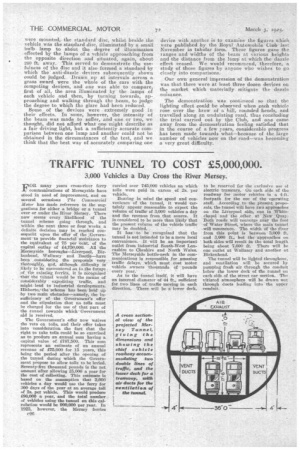TRAFFIC TUNNEL TO COST £5,000,000.
Page 10

If you've noticed an error in this article please click here to report it so we can fix it.
3,000 Vehicles a Day Cross the River Mersey.
FOR. many years cross-river ferry cernmanicatiens of Merseyside have stood in need of improvement, and on several occasions The Commercial Motor has made reference to the suggestions for either a bridge or a tunnel over or under the River Mersey. There now seems every likelihood of the tunnel scheme going through, and within the next three or four weeks a definite decision may be reached conoequent upon the offer of the ',Government to provide financial assistance to the equivalent of 75 per :cent. of the capital outlay of 14,750,000. All the Merseyside boroughs—Liverpool, Birkenhead, Wallasey and Bootle—have been considering the'proposals very thoroughly, and, although difficulty is likely to he encounteredas to the future of the existing ferries, it is reco,gnized -that the tunnel would be the means of considerably ex,pediting traffic, and might lead to industrial developments. Hitherto,' the-scheme has been held' up by two main obstacles—namely, the insufficiency of the Government's offer and the stipulation that no tolls must he charged for the use of that part of the tunnel towards which Government aid is received.
The Government's offer now waives the veto on tolls, and their offer takes into consideration the fact that the right to take tolls -could be so exercised as to produce an annual sum having a capital value of 1787,500. This sum represents an estimate of an annual revenue of £75,000 for 15 years, this being the period after the opening of the tunnel during which the Government propose to allow tolls to be levied. Seventy-five thousand pounds is the net amount after allowing £5,000 a year for the cost of collecting_ This estimate is based on the assumption that 3,000 vehicles a day would use the ferry for :100 days of the year at an average tall of 2s. per vehicleThie would produce 190,000 a year, and the total number of vehicles using the tunnel on this calculation would be 000,000 per year. In 1923, however, the Mersey ferries
e2(I carried over 745,000 vehicles on which tolls were paid in excess of 2s. -per vehicle.
Bearing in mind the speed and convenience of the tunnel, it would certainly appear reasonable to expect the volume of traffic of 2,000 vehicles a day and the revenue from that source. It is considered to be more than likely that the present volume of the vehicle traffic may be doubled.
It has to be recognized that the tunnel is not intended to be a mere local convenience. It will be an important outlet from industrial South-West Lancashire to Cheshire and North Wales. The Merseyside bottle-neck in the communications is responsible for amazing traffic delays, which must cost meter vehicle owners -thousands of pounds every year.
As to the tunnel itself, it will have an internal diameter of 44 ft., sufficient for two lines of traffic moving in each direction. There will be a lower deck,
to be reserved for the exclusive use of electric tramcars. On each side of the roadway for motor vehicles is a 4-ft. footpath for the use of the operating staff. According to the .present proposals, the tunnel will have two approaches on the Liverpool side, one in Whitechapel and the other at New .Quay. Both roads will converge near the foot of 'Water Street, where the main' tunnel will contrnenee. The width of the Jiver from this point is between 3,000 ft. and 3,600 ft., but theapproaches on ' both sides will result in the total length being about 7,000 ft. There will be one outlet at Wallasey and another at Birkenhead.
The tunnel will be lighted throughout. and ventilation will be secured by pumping fresh air through the conduit below the lower deck of the tunnel on each side of the street car section. The vitiated atmosphere will be drawn -cut through ducts leading into the upper coednit.




























